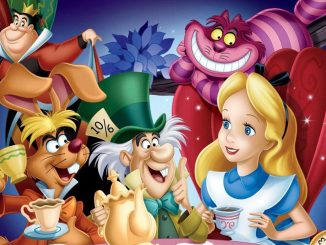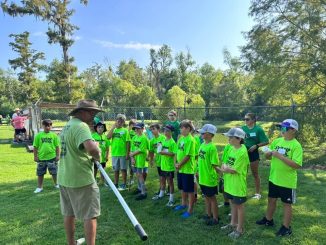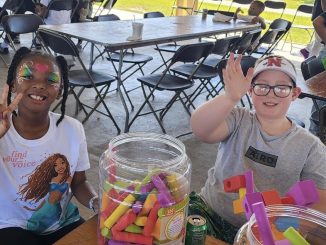
After riding in the Krewe of Des Allemands parade, Vernon Higgins decided it was time to turn talk into action about forming their own parade in Luling.
It was 1978 when Higgins went to the courthouse and got the permit that started the Krewe of Lul.This year, the krewe is celebrating its 40th anniversary.
“I think it’s been good, but I get a lot of people who think I did it,” he mused. “I think I get the credit because I went get the permit.”
Despite his humility, Higgins is deeply connected to what he created.
“We rode on a Sunday morning the first year with six floats,” he said.
With permit in hand, Higgins said the parade included himself and friends along with the Harmon and Tucker families who rolled on Sunday morning on decorated 18 wheelers, making it the krewe’s first parade. John and Jennie Buscalacchi were the krewe’s first king and queen.They just loved to ride.
The floats often rolled with Krewe of Lul in the morning and then Krewe of Des Allemands that afternoon when the parades were on the same day.
But, even so, Higgins said it isn’t uncommon for them to roll in both parades today either even though Lul rolls on Saturday and Des Allemands’ parade takes place the next day.
To help raise parade funds, Higgins recalled how they sold advertising. He considered it fun.
“I ran it for the first nine years,” he said. “I was the president and then after that Russell Lauve and other people took over.”
These many years later, Higgins, now 67, said he’s glad he did it.
“I could remember one year when we turned onto Paul Maillard Road and my buddy said, ‘Look at the crowd down the road. You started this.’ It was a good feeling.”
Many people came together to help make it happen, Higgins recalled.
Trucks were donated to decorate as floats that help cut expenses, he said. Many friends stepped up in many ways that made the Mardi Gras parade possible, he said.
“People just wanted to be a part of it after a while,” Higgins said. “There were a lot of people who wanted to do it. We had no trouble getting crowds.”
For its founder, the truest meaning of the parade came to be how it brought families together both on the floats and along the route.
“It was just good to see the families out … the young kids,” Higgins said. “The family setting was there. People would party on the levee and they would bring BBQ pits and campers, and everything else.”
Calling it a “family day,” he recalled groups of people getting together to start decorating their floats a month before the parade. Then, he’d watch them having fun along the parade route.
It all comes together as a big family gathering, both on the floats and on the streets of Luling, Higgins said.
Over the years, he recounted times with the parade when the train crossed the tracks and split the lineup, leaving the front half of the parade waiting on the second half. One year, a storm blew through the night before and tore off float decorations, which had to be put back on the floats, he said. Several times before a parade, he recalled trailers being stuck when they tried to hook up the floats.
Fortunately, Higgins said his worst fears, such as a serious accident or someone getting hurt, never materialized.And the parade has changed in some ways, but he’s unhappy with one in particular.
It used to roll at 1 p.m., but now it rolls at noon, which Higgins said leaves paradegoers less time to set up tailgate parties on the levee. They also used to stay after the parade for partying, which he thinks fewer people are doing.
Other than that, he’s pleased with how the Krewe of Lul has evolved over the years and especially with how the community came together to bring a little revelry to Luling.
“I was surprised at how many people were willing to help,” Higgins said. “If you ask for a little help, they were ready to do it.”




Be the first to comment